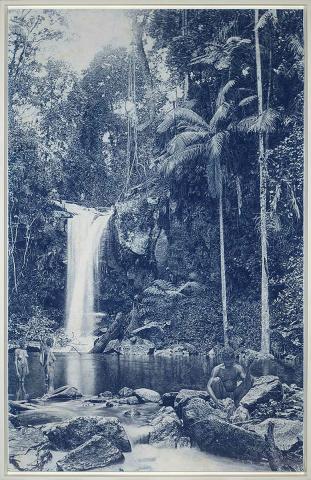ESSAY: Danie Mellor: The pleasure and vexation of history
The pleasure and vexation of history 2017 is a major work by important contemporary Indigenous Australian artist Danie Mellor, in which he purposefully fabricates an imaginary interaction between his ancestors and European settlers within one of his signature rainforest scenes, meticulously drawn in blue. Mellor’s statement about the work sets the scene:
'The pleasure and vexation of history is a piece that suggests a scene reminiscent of a tropical paradise, an idyll of tranquillity. The image shows a waterfall, and the deep pool into which it pours surrounded by lush and verdant rainforest. The imagery seems to overstate itself, overemphasising the fact of its natural perfection and charming beauty that invites an experience of the picturesque and unspoilt. As if confirming the postcard allure and naturalness of the space, three Aboriginal people are present. They are absorbed in their surroundings, unaware perhaps of a European male figure surveying the scene, gazing down at them. It presents a synopsis of power, an uncomfortable even sinister interruption to the allegorical story of timeless harmony unfolding. The pleasure and vexation of history subverts expectations and the propaganda of fabricated utopias. Its imagery deliberately invokes stereotypes and disarming clichés, and plays on historical narratives generated from unfounded assumptions around Aboriginal people and their cultural and social practice. In this piece, the pleasure of the gaze is heightened in the enchantment of a scene that connotes historical authenticity, and then countered with the vexation of multiple narratives that deviate from and coalesce around attested reality.'(1)
Mellor’s composition plays with the dichotomy between the imagined utopias of the colonial frontier and the dystopic realities for the Indigenous peoples and societies that lay in its path. Here, Mellor utilises a format and composition reminiscent of early carte-de-visites and postcards produced in the rainforest, which similarly posed Bama naturalistically within an idealistic lush rainforest setting, often juxtaposed with a well-dressed European figure to reinforce the hierarchies of colonial power. Mellor’s use of the colour blue also speaks to ideas of creating consumable colonial or frontier utopias, with the artist first encountering blue landscapes on Spode dinner ware and tea sets while studying in Birmingham. These images portrayed ‘other’ places, cultures and scenes in blue, with romanticised elements heightening the exoticness of these places in the imaginations of consumers of these popular products. Mellor’s works continue to play on these tropes by exaggerating an ideal naturalistic scene. Like Mellor’s best works, The pleasure and vexation of history powerfully but subtly allows us to witness the collision of historical contrivance and Indigenous knowledges.
Bruce Johnson McLean, former Curator, Indigenous Australian Art, QAGOMA, August 2019.
Endnote
'The pleasure and vexation of history is a piece that suggests a scene reminiscent of a tropical paradise, an idyll of tranquillity. The image shows a waterfall, and the deep pool into which it pours surrounded by lush and verdant rainforest. The imagery seems to overstate itself, overemphasising the fact of its natural perfection and charming beauty that invites an experience of the picturesque and unspoilt. As if confirming the postcard allure and naturalness of the space, three Aboriginal people are present. They are absorbed in their surroundings, unaware perhaps of a European male figure surveying the scene, gazing down at them. It presents a synopsis of power, an uncomfortable even sinister interruption to the allegorical story of timeless harmony unfolding. The pleasure and vexation of history subverts expectations and the propaganda of fabricated utopias. Its imagery deliberately invokes stereotypes and disarming clichés, and plays on historical narratives generated from unfounded assumptions around Aboriginal people and their cultural and social practice. In this piece, the pleasure of the gaze is heightened in the enchantment of a scene that connotes historical authenticity, and then countered with the vexation of multiple narratives that deviate from and coalesce around attested reality.'(1)
Mellor’s composition plays with the dichotomy between the imagined utopias of the colonial frontier and the dystopic realities for the Indigenous peoples and societies that lay in its path. Here, Mellor utilises a format and composition reminiscent of early carte-de-visites and postcards produced in the rainforest, which similarly posed Bama naturalistically within an idealistic lush rainforest setting, often juxtaposed with a well-dressed European figure to reinforce the hierarchies of colonial power. Mellor’s use of the colour blue also speaks to ideas of creating consumable colonial or frontier utopias, with the artist first encountering blue landscapes on Spode dinner ware and tea sets while studying in Birmingham. These images portrayed ‘other’ places, cultures and scenes in blue, with romanticised elements heightening the exoticness of these places in the imaginations of consumers of these popular products. Mellor’s works continue to play on these tropes by exaggerating an ideal naturalistic scene. Like Mellor’s best works, The pleasure and vexation of history powerfully but subtly allows us to witness the collision of historical contrivance and Indigenous knowledges.
Bruce Johnson McLean, former Curator, Indigenous Australian Art, QAGOMA, August 2019.
Endnote
- Artist's statement, provided by Jan Murphy Gallery, 11 May 2018.
